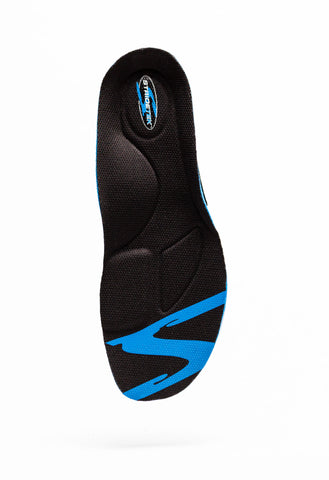- Continue Shopping
- Your Cart is Empty
What's In a Name? A Primer on Inserts, Orthotics, and Arch Supports.
Running shoes. Pretty much everybody knows what those are. But what about orthotics, arch supports, gel inserts, cushion inserts, arch cushions, heel pads, heel cups, etc.? It seems like those terms are used somewhat interchangeably. So why does any of this matter? The answer is that it can be confusing and overwhelming when suddenly faced with an injury situation that may require more than just a new pair of shoes.

Many well-meaning companies have contributed considerably to the confusion surrounding what the function is to each of these different items that can be placed into your shoes, often in place of the removable liner that comes with your running shoes. The terms “inserts” and “insoles” refer to the same thing and can be used interchangeably.
What follows is a primer on what all of these things are, what they do, when you might need them, and about how much they cost. Below are the 7 basic types of insoles that can be inserted into your running shoes.
- Shoe liners…these are generally removable, thin, lightweight pieces of foam and/or other materials that have the same shape as the shoe and protect the foot from the stitching and seams in the bottom of the shoe. Some companies now make these out of more substantial materials, serving to provide additional support and cushioning to the shoe. Shoe liners may need to be replaced before the running shoe wears out. They are included with your running shoes when you purchase them.
- Cushion inserts…are very similar to a shoe liner, but have thicker foam. Their purpose is just what the name suggests – provide more cushioning. The key is that they are usually the same thickness everywhere, and do not attempt to provide additional support in the arch or other areas. However, some models will put a little extra thickness in the heel. The benefit to cushion inserts is a more cushioned ride, plus, they can extend the life of a pair of running shoes. The downside to these and the other more substantial inserts is that they can affect the fit of the shoe by taking up too much volume. Cushion inserts are generally in the $20 per pair price range.
- Gel inserts…Gel inserts are similar to cushion inserts, but have the added cushioning of a gel material in the heel area. The idea is that the gel provides more cushioning than does foam, and does not break down as quickly. Someone might use gel inserts if they are a heavy heel striker. Gel inserts use to cost more than cushion inserts, but are now priced about the same.
- Arch cushions…these are similar to cushion inserts, but the goal is to support the arch with additional foam material. The benefit to arch cushions is that they can help to correct overpronation or provide support to a high-arched foot. Runners with shin splints, plantar fasciitis, and some knee problems may find relief with arch cushions. Likewise, arch cushions cost about the same as cushion inserts.
- Arch supports…are very similar to arch cushions and are used for the same problems. However, arch supports generally use a rigid material, such as plastic or carbon fiber, to support the arch in conjunction with additional foam cushioning. Heavier runners and very flat-footed individuals are usually the intended user of arch supports. Arch supports generally cost closer to the $50 price point.
- Orthotic insoles…Here is where things can get a little fuzzy. The line between arch supports and orthotic inserts is really not clearly defined and many companies throw around the term “orthotic” very liberally. However, orthotic insoles are corrective in nature and offer support to more than just the arch. Often there is support to the metatarsal area of the foot, and the components of the device work together to provide correction throughout the foot strike. The goal of this integrated device is to ensure proper biomechanics throughout the stride. Orthotic insoles range anywhere from around $50 - $125.
- Custom orthotics… When most medical professionals refer to orthotics, they are talking about inserts that custom made to the foot of each individual patient. Generally, molds are taken of each foot and then the molds are sent to a lab to be built. However, custom orthotics can also range from being made of some type of foam to being constructed of rigid plastic or carbon fiber, as well as a combination of materials. The upside is that custom orthotics have been designed specifically for your foot. The downside to custom orthotics is that they can run as high as $1,000 per pair, and there is no guarantee that they will work.
Of course, all of the inserts listed above are full-length, meant to replace the stock liner in your running shoes. Be aware that there are an endless variety of hybrids of the above inserts, but this primer will hopefully have given the reader a general understanding of the basic terms. There are also heel cups, heel pads, metatarsal pads, etc. that can be added into non-running shoes, such as dress shoes, high heels, slippers, etc.
